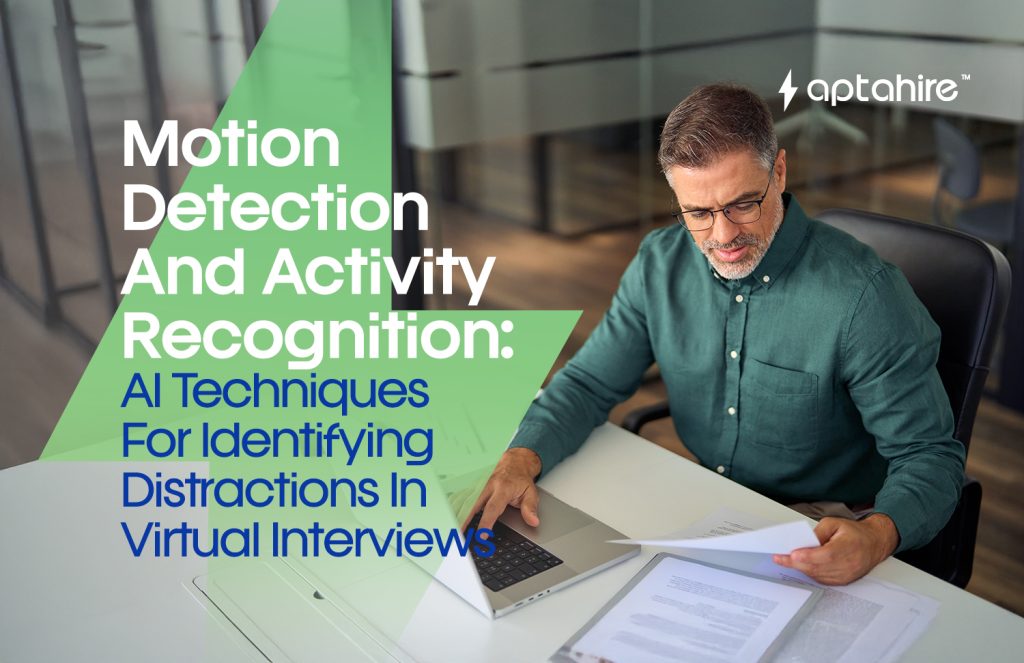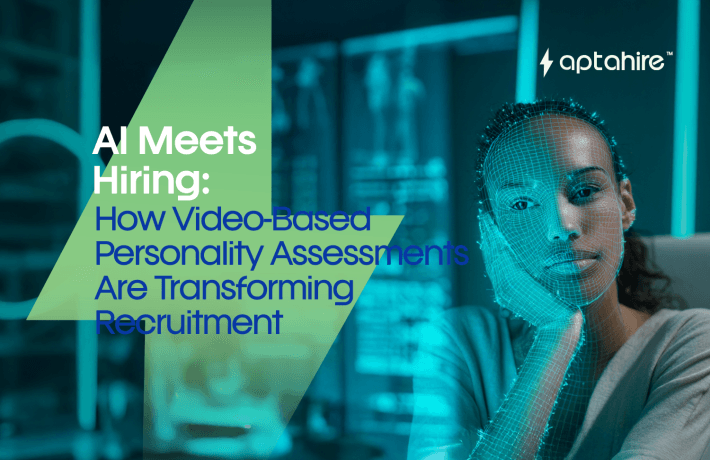Motion Detection and Activity Recognition: AI Techniques for Identifying Distractions in Virtual Interviews

The Rise of Virtual Interviews, And the New Set of Challenges They Bring
The digital hiring landscape has evolved rapidly in recent years. According to a 2023 report by LinkedIn, over 81% of hiring managers now conduct interviews virtually, whether for initial screening or final rounds.
While this shift has improved convenience and accessibility, it has also opened the door to new forms of candidate manipulation and distraction. In fact, a survey by Checkster revealed that 33% of job applicants admitted to cheating during online interviews, from getting help off-camera to searching answers in real-time.
So how can employers maintain the integrity of virtual interviews?
Enter Motion Detection and Activity Recognition, a powerful suite of AI technologies that doesn’t just watch but understands human behavior during interviews.
What is Motion Detection & Activity Recognition?
Think of motion detection as the “eyes” of AI, tracking movement patterns in real-time.
Now add a “brain” to those eyes, and you get activity recognition, where AI interprets the intent behind movements. It’s not just “the person moved their hand” but rather “the person is typing something” or “looking at a different screen.”
These two systems working together form the core of behavioral analysis in AI-powered virtual hiring.
Why Identifying Distractions Matters in Interviews
Virtual distractions aren’t always deliberate, but they affect authenticity, engagement, and performance metrics.
Let’s look at a few scenarios:
- A candidate frequently glances at another screen (could be reading answers)
- Someone enters the room during a test
- The candidate whispers responses, possibly repeating what someone else is saying
- Constant fidgeting could signal nervousness, or hidden cues from an off-camera prompter
According to research by Harvard Business Review, interviewer impressions in the first 90 seconds of an interview often determine the outcome. Distractions during this window can disproportionately affect both perception and evaluation.
How AI Actually Detects These Distractions
Let’s break down the technology stack that enables motion and activity analysis:
1. Computer Vision (CV) Algorithms
Computer Vision enables machines to see and interpret visual information. In virtual interviews, CV algorithms:
- Track eye movement (using eye-tracking models)
- Detect head pose and direction
- Identify hand gestures and body posture
Example: A candidate looking away from the screen for more than 3 seconds gets flagged.
2. Pose Estimation Models
Tools like OpenPose, MediaPipe, or BlazePose are used to map:
- 18–33 human body keypoints (eyes, elbows, knees, etc.)
- Real-time posture changes
- Repetitive or unusual motions
This allows AI to spot:
- Typing patterns
- Phone usage beneath the camera view
- Gestures indicating whispering or signaling
3. Audio-Visual Sync Analysis
AI can also match lip movement with speech. If there’s a mismatch, it may mean:
- The person is mouthing words
- Someone else is speaking in the background
- Deliberate audio masking
Platforms also detect background audio anomalies, such as:
- Faint speaking
- Keyboard sounds unrelated to the interview platform
- Ambient voice prompts
4. Temporal Action Detection (TAD)
AI models track behavior over time, not just snapshots. Temporal analysis helps recognize:
- Patterns (e.g., candidate looks to the left every time a technical question is asked)
- Duration and frequency of distractions
- Correlation between specific actions and candidate responses
This leads to an AI-generated “distraction timeline”, helping interviewers replay and review key moments.
Real-World Data: How Often Do Distractions Happen?
AI hiring platforms like Aptahire, HireVue, and Modern Hire now use distraction detection as a standard feature. Here’s what internal data from one platform revealed:
| Behavior Detected | Frequency (%) of Interviews |
| Looking away repeatedly | 42% |
| Background noise detected | 29% |
| Hand movement below frame | 35% |
| Off-screen whispering | 16% |
| Presence of second person | 9% |
Source: Aggregated anonymized data from AI interview tools (2024)
The Distraction Scoring System: What Recruiters See
Rather than giving a binary “cheated/not cheated” report, AI platforms now provide a distraction scorecard.
A sample report might include:
- Focus Score: 82% (based on eye contact and engagement)
- Environmental Noise: Medium (background sounds detected)
- Motion Anomalies: High (frequent hand and head movement)
- Interruption Events: 3 (audio prompts or screen deviation)
Recruiters can then review:
- The interview timeline
- Highlighted sections with distraction events
- Suggested follow-up actions
Ethical Considerations: Is AI Being Too Invasive?
Good question, and a valid one.
To ensure fairness and privacy:
- Platforms provide disclosure and consent before recording or analyzing
- AI decisions are never fully automated; they support, not replace, human judgment
- Candidates have the right to review and contest assessments
A responsible AI system should follow the principles of:
- Transparency
- Bias mitigation
- Data minimization
- Human oversight
Benefits of Motion Detection in Virtual Hiring
Let’s wrap the tech into what it actually brings to the table:
| Benefit | Explanation |
| Improved Authenticity | AI flags when a candidate seems distracted or externally prompted |
| Faster Screening | Recruiters get summary insights, reducing interview review time |
| Bias Reduction | Objective tracking of behavior vs. human “gut feelings” |
| Secure Assessment Environment | AI helps detect and prevent manipulation or cheating |
| Richer Behavioral Data | Learn about how candidates react to pressure, not just what they say |
But Wait, Can’t People Just Outsmart the System?
Some try, by using eye-level cue cards, concealed microphones, or hidden prompts.
But AI systems are evolving:
- Infrared camera integration for gaze accuracy
- Environmental anomaly tracking (unexpected lighting shifts = someone enters room)
- 3D space detection to measure movement depth (e.g., leaning to read something)
In short, the arms race between deception and detection is real, but AI is becoming increasingly adept at contextually interpreting behavior.
Final Thoughts: It’s Not Just About Catching People, It’s About Creating Equal Opportunity
Let’s get one thing straight: AI-based motion and activity detection isn’t about playing Big Brother. It’s about ensuring every candidate gets a fair shot by minimizing external influence.
In a world where a few keystrokes can alter outcomes, maintaining authenticity is not just nice, it’s necessary.
By combining motion detection, behavior analysis, and ethical AI practices, modern hiring platforms are leveling the playing field, ensuring the candidate who earns the role is the one who truly deserves it.
TL;DR
AI in hiring isn’t just about parsing resumes anymore. With motion detection and activity recognition, it can now see, interpret, and report on candidate focus, behavior, and distractions, helping recruiters hire better, faster, and more fairly.
FAQs
1. What exactly does AI monitor during a virtual interview?
AI monitors a combination of visual, audio, and behavioral cues. This includes eye movement, facial orientation, hand gestures, posture, lip synchronization, background motion, and ambient sound. The goal is to detect signs of distraction, external assistance, or lack of engagement in a non-intrusive and ethical manner.
2. Can AI tell the difference between a nervous candidate and a cheating one?
Yes, to an extent. Advanced AI models use temporal and contextual analysis to differentiate between natural behavior (e.g., fidgeting from nervousness) and suspicious patterns (e.g., repeating glances to the left only during technical questions). However, final decisions are always left to human recruiters who interpret the AI’s findings.
3. How accurate is motion detection and activity recognition in identifying distractions?
Modern systems can achieve accuracy rates of 85–93% when detecting visual distractions, especially when multiple data points (eye tracking + posture + audio) are combined. However, the accuracy depends on video quality, lighting conditions, and camera placement, so a margin of error is expected and accounted for.
4. Is this technology fair to all candidates, including those with neurodiverse conditions?
Ethical platforms are now working towards bias mitigation by training models on diverse data sets, including candidates with ADHD, autism spectrum disorders, and anxiety. AI-generated distraction scores are never used as the sole basis for rejection. Recruiters are encouraged to review the context behind any flagged behaviors.
5. Can this AI detect if someone else is in the room?
Yes. AI can detect:
- Shadow movements in the background
- Unusual audio patterns (like whispers)
- New object appearances (like another person walking in)
- Off-angle eye movement or body orientation that indicates interaction with someone off-camera
These patterns trigger alerts to notify the recruiter of possible third-party presence.
6. What happens if the AI wrongly flags a distraction?
Candidates are usually not penalized automatically. Recruiters receive detailed reports with timestamps and playback options so they can verify whether the distraction was significant. Most platforms also allow for candidate feedback or appeals in case of technical or environmental misinterpretations.
7. Are candidates informed that motion and behavior will be tracked?
Yes. Ethical AI hiring platforms clearly state, usually during scheduling or before the interview begins, that the session will be recorded and analyzed for engagement, behavior, and integrity. This ensures transparency and informed consent, which are cornerstones of responsible AI use.
8. Can candidates do anything to reduce false flags or distractions during the interview?
Absolutely! Here are a few tips:
- Use a quiet, well-lit room
- Keep your face clearly visible on camera
- Avoid multitasking or checking other screens
- Disable background apps that may cause pop-up sounds
- Inform others not to interrupt during the session
These practices help ensure a smooth and authentic interview experience, and minimize unnecessary AI alerts.



